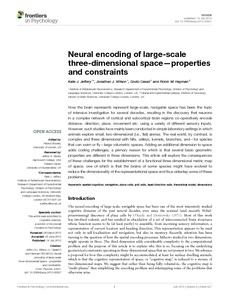Jeffery, KJ;
Wilson, JJ;
Casali, G;
Hayman, RM;
(2015)
Neural encoding of large-scale three-dimensional space-properties and constraints.
Frontiers in Psychology
, 6
, Article 927. 10.3389/fpsyg.2015.00927.

![[thumbnail of Neural encoding of large-scale three-dimensional space-properties and constraints..pdf]](https://discovery.ucl.ac.uk/1472605/1.hassmallThumbnailVersion/Neural%20encoding%20of%20large-scale%20three-dimensional%20space-properties%20and%20constraints..pdf)  Preview |
Text
Neural encoding of large-scale three-dimensional space-properties and constraints..pdf
Download (2MB)
| Preview
|
Abstract
How the brain represents represent large-scale, navigable space has been the topic of intensive investigation for several decades, resulting in the discovery that neurons in a complex network of cortical and subcortical brain regions co-operatively encode distance, direction, place, movement etc. using a variety of different sensory inputs. However, such studies have mainly been conducted in simple laboratory settings in which animals explore small, two-dimensional (i.e., flat) arenas. The real world, by contrast, is complex and three dimensional with hills, valleys, tunnels, branches, and-for species that can swim or fly-large volumetric spaces. Adding an additional dimension to space adds coding challenges, a primary reason for which is that several basic geometric properties are different in three dimensions. This article will explore the consequences of these challenges for the establishment of a functional three-dimensional metric map of space, one of which is that the brains of some species might have evolved to reduce the dimensionality of the representational space and thus sidestep some of these problems.
| Type: |
Article
|
| Title: |
Neural encoding of large-scale three-dimensional space-properties and constraints |
| Location: |
Switzerland |
| Open access status: |
An open access version is available from UCL Discovery |
| DOI: |
10.3389/fpsyg.2015.00927 |
| Publisher version: |
http://dx.doi.org/10.3389/fpsyg.2015.00927 |
| Language: |
English |
| Additional information: |
© 2015 Jeffery, Wilson, Casali and Hayman. This is an open-access article distributed under the terms of the Creative Commons Attribution License (CC BY). The use, distribution or reproduction in other forums is permitted, provided the original author(s) or licensor are credited and that the original publication in this journal is cited, in accordance with accepted academic practice. No use, distribution or reproduction is permitted which does not comply with these terms. |
| Keywords: |
dimensions, grid cells, head direction cells, navigation, place cells, spatial cognition, theoretical model |
| UCL classification: |
UCL
UCL > Provost and Vice Provost Offices > School of Life and Medical Sciences
UCL > Provost and Vice Provost Offices > School of Life and Medical Sciences > Faculty of Brain Sciences
UCL > Provost and Vice Provost Offices > School of Life and Medical Sciences > Faculty of Brain Sciences > Div of Psychology and Lang Sciences
UCL > Provost and Vice Provost Offices > School of Life and Medical Sciences > Faculty of Brain Sciences > Div of Psychology and Lang Sciences > Experimental Psychology
UCL > Provost and Vice Provost Offices > School of Life and Medical Sciences > Faculty of Brain Sciences > UCL Queen Square Institute of Neurology
UCL > Provost and Vice Provost Offices > School of Life and Medical Sciences > Faculty of Brain Sciences > UCL Queen Square Institute of Neurology > Clinical and Experimental Epilepsy
UCL > Provost and Vice Provost Offices > School of Life and Medical Sciences > Faculty of Life Sciences
UCL > Provost and Vice Provost Offices > School of Life and Medical Sciences > Faculty of Life Sciences > Div of Biosciences
UCL > Provost and Vice Provost Offices > School of Life and Medical Sciences > Faculty of Life Sciences > Div of Biosciences > Cell and Developmental Biology |
| URI: |
https://discovery.ucl.ac.uk/id/eprint/1472605 |
Download activity - last month

 Loading...
Loading...Download activity - last 12 months

 Loading...
Loading...Downloads by country - last 12 months

 Loading...
Loading...Archive Staff Only
 |
View Item |

